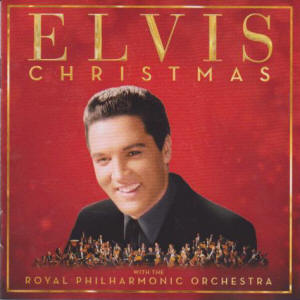

On October 6, 2017 RCA released "Elvis:
Christmas With The Royal Philharmonic
Orchestra". The album could be purchased in form
of a standard compact disc, a vinyl record and
digital download. Of course it was also
available for streaming. A little later RCA
offered a special edition (with bonus tracks) as
well as a double-cd featuring the new Xmas album
as well as the previous RPO release "The Wonder
Of You".
On the Billboard Charts the album peaked at
number 1 (Classical Sales Chart), 4 (Holiday
Sales Chart) and 73 (Billboard 200). In the UK
it reached number 6 and in Australia it peaked
at number 7. The BPI (British Phonographic
Industry) honored the UK sales with a Gold
Award. "Elvis: Christmas With The Royal
Philharmonic Orchestra" was a success, but it
didn't sell as well as the previous RPO
collaborations.
Today the album is available in 24 bit/90 khz
flac. That means, if the platform of your choice
supports high resolution audio, you can enjoy
the tracks in the same quality Sony used to scan
and master them. On Spotify, which has a market
share of approximately 30% and is the only
platform that publishes streaming figures,
"Elvis: Christmas With The Royal Philharmonic
Orchestra" accumulates 41 million streams. Its
precedessors "The Wonder Of You" and "If I Can
Dream" clock in at 161 million and 198 million
streams.
As usual the album was produced by Nick
Patrick and Don Reedman, who also functioned as
executive producer along with Priscilla Presley.
The rhythm tracks were produced by Peter Schwier
at Bunker Studio and Shine Studio. The band
consisted of John Parricelli (guitar), Laurie
Cottle (bass), Ralph Salmins (drums), Richard
Cottle (piano and saxophone) as well as Nick
Patrick and Don Reedman (percussion and
programming of the drum computer). The harmony
vocals were provided by Andy Caine, Miriam Grey,
Shena Winchester, Andrew Playfoot and Phoebe
Street. The contributions of The Royal
Philharmonic Orchestra were recorded under the
guidiance of Peter Cobbin at Abbey Road Studios.
The different bits and pieces were mixed by
Peter Schwier at Shine Studio, the mastering was
done by Vic Anesini at The Battery Studios in
New York.
Because almost half of the king's Xmas songs
were recorded in mono, the complete original
recordings had to be used. Back in the 1950s all
instruments and voices were recorded on a single
track and in the middle of the 2010s there was
no technology to separate the bits and pieces.
To enhance the sound, the singers and musicians
had to copy what was on the original recording.
Even though further elements could be added, the
producers were somewhat limited in what they
could do with the songs.
The booklet starts with an introduction by
Priscilla Presley, in which she describes her
first Xmas with the king. Besides that, she
claimes, that Elvis loved Christmas and
certainly would have been pleased to do an album
like this. Of course this was pure marketing,
because his longplayer "Elvis Sings The
Wonderful World Of Christmas" (1971) does
feature an orchestra and a choir. Besides that,
the king always took an orchestra and many
harmony singers on tour with him.
Santa Claus Is Back In Town!
The mono recording was enhanced with guitar,
bass, drums, piano and harmony vocals. Even
though the complete original recording had to be
used, there is not much left of the
aggressiveness. Robin Smith' big band
arrangement is nice to hear, but lightyears away
from what Elvis had released back in 1957.
White Christmas
The Xmas classic, also recorded in the 1950s,
wasn't changed all that much. Basically just The
Royal Philharmonic Orchestra and harmony voices
have been added. I am not a fan of the king's
version of "White Christmas", for me the new
incarnation is somewhat of an improvement.
Here Comes Santa Claus (Right Down Santa
Claus Lane)
Mr. Smith added a saxophone, a choir and the
inevitable orchestra. I like the big band sound
of this version very much.
Merry Christmas Baby
This one was taped in early 1971, so the
producers were able to work with a multi-track
recording. Sally Herbert wrote an orchestra
arrangement, that is somewhat reminiscent of the
"Steamroller Blues". The result sounds less raw
than the original recording, but if Elvis had
presented "Merry Christmas Baby" on stage, his
rendition might have sounded similar.
Blue Christmas
This is Elvis' most famous Xmas song.
Robin Smith simply added strings and harmony
voices to the mono recording. It doesn't sound
much different, but more voluminous and (due to
the improved recording technology) modern.
I'll Be Home For Christmas
To extend the song, Robin Smith simply repeated
a part of the mono recording and linked the
pieces with a saxophone solo. The trick works
very well, I also like the idea, to play the
drums with brushes.
Winter Wonderland
When Elvis recorded this seasonal classic in
1971, he did little to hide his boredom.
However, the band (especially James Burton)
saved the track by playing in a rockin' style.
Sally Herbert's big band arrangement takes away
all the edges and turns the "Winter Wonderland"
into a musical wasteland.
Santa Bring My Baby Back (To Me)
Once again we hear a typical big band
arrangement, but this time it works well. The
original mono recording is cleverly supported by
the additional musicians and singers.
Silver Bells
The original release from 1971 also features an
orchestra. Sally Herbert wrote a new
orchestra-arrangement and added more harmony
voices. Both versions are nice to hear.
O Little Town Of Bethlehem
Robin Smith added harmony vocals and the string
section of The Royal Philharmonic Orchestra. It
all sounds very tasteful and improves the old
mono recording.
O Come All Ye Faithful
Elvis' version sounded bombastic and kitschy,
but it also featured a surprisingly rockin'
drum. The remake does not and so everything
babbles on uneventfully and boring. Just like
"Winter Wonderland", this remake is a
debasement.
The First Noel
In contrast to many of Elvis' other recordings
from the 1970s, this one was arranged quite
simple and sparse. Sally Herbert enhanced the
track with lots of choires and strings and added
an intro as well as a bridge. The result sounds
vastly different, but I like it a lot.
Silent Night
As you might know, I don't like the king's
version of "Silent Night". Simply, because in
1957 he lacked the emotional debth and vocal
abilities to perform the song. Robin Smith added
an orchestra, which somewhat covers up the
shortcomings of the young singer.
Peace In The Valley
This is one of my favorite recordings from the
1950s. Here Elvis gets it all right. The vocal
technique, the emotion, just everything. The
mono recording was enhanced with The Royal
Philharmonic Orchestra, harmony voices and newly
recorded instruments, which mirror the stuff on
the original recording. The result sounds
stunning, for me this is the ultimate version of
"Peace In The Valley" and the highlight of this
album!
I Believe
The mono track was enhanced with a new intro, a
new bridge and of course strings and harmony
voices. The result sounds more voluminous and
due to the advanced recording technology also
more modern.
Take My Hand, Precious Lord
The same applies here. This time Robin Smith
added a string intro.
It Is No Secret (What God Can Do)
The RPO version was created with the same
procedure. The musicians copied the stuff on the
mono track and the whole thing was enhanced with
The Royal Philharmonic Orchestra and additional
harmony voices.
Verdict
The arrangements are conservative and
winsome, everything is presented without any
edges and in technical perfection. Compared
to Presley's original recordings the remakes
sound more voluminous and modern
(sound-wise), but in some cases also less
exciting.

(C) Sony Music
Entertainment
![]()

